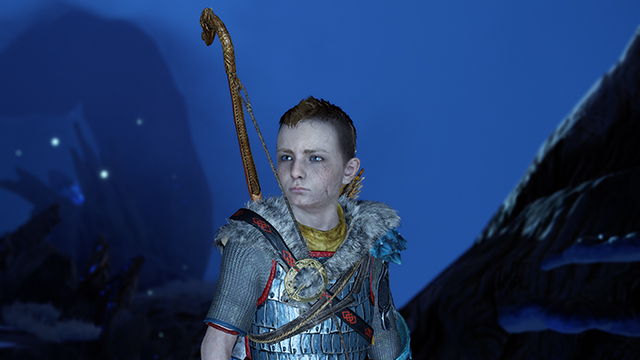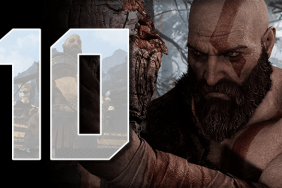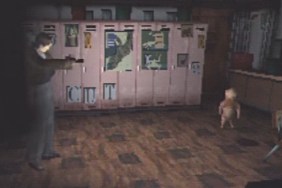To celebrate the one-year anniversary of God of War, we’ll be publishing (or republishing) some deep dives on how the Game of the Year winner came to be based on some GDC 2019 talks.
Children are generally the silver bullet that can kill almost any game. Few titles take the time to make them mechanically or narratively engaging so it takes a game like The Last of Us and The Walking Dead to be the exceptions for problem that plagues the whole industry. God of War, while thoroughly praised for other aspects, stood out in 2018 for not only its portrayal of Atreus, but also his mechanical significance. He was a genuine help in combat and grew over the course of the story; a narrative and gameplay success. Despite the results, he was a pain to implement and fine tune and spent most of God of War’s development on the cusp of being cut.
Hayato Yoshidome, senior combat tech designer, was in charge of Atreus like a parent, which he learned from Naughty Dog’s Max Dyckhoff, the “father” of Ellie in The Last of Us. He even got a portrait of Atreus framed by his desk. But instead of thinking of him solely as his digital son, he found out that treating the boy more like a teammate would be better for gameplay. That mission statement was far easier said than done since the creation of Atreus took many retries and ton of overhauls.
Atreus had to do four things: support players, not hinder the player, always be helpful, and not be something to babysit. Any failure in the latter three meant that it would be yet another bad video game escort quest. But how do you support a one-man army like Kratos? Yoshidome sarcastically internalized this by throwing a bit of a lighthearted jab at director Cory Barlog.
“Nobody was saying ‘you know what Kratos needs? A child fighting with him in battle.’ Nobody was saying that maybe except for one director,” he said.
Hawkeye and Thor
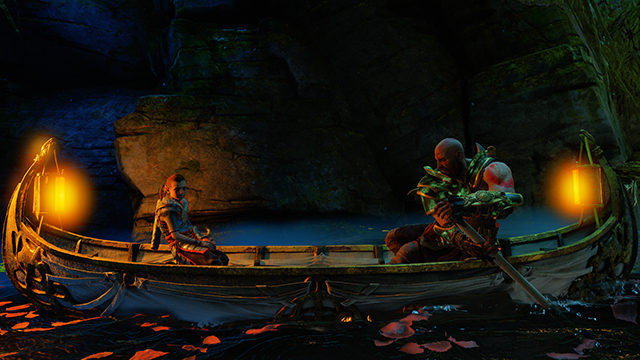
Framing this in a different context helped Yoshidome realize the direction to go in. He likened it to the Avengers, where Thor is ripping multiple opponents up at a time and Hawkeye is doing his best. Both are effective on different scales but are each working as a team to get to their goal more quickly even if one of them is a literal god of war.
And like Hawkeye, Atreus initially would initiate fights by taking the high ground, rooting enemies in place, or taking away their weapons. But this led to problems as it meant players were being stealthy and mindlessly using Atreus since they could order to him to go do his own thing shortly before forgetting about him. Yoshidome then reacted by altering Atreus to be more offensive and damage enemies but players weren’t focusing on him at all. The more involved control used to combat the previous iteration’s mindlessness flipped the other way since he was too involving and players would only use Kratos in the heat of battle.
This was when God of War was super grounded at first, meaning enemies would also die in three hits, something that later changed but made it hard to make Atreus feel weaker than Kratos but effective nonetheless. But this change pointed out how Atreus could distract enemies and is where the game started to click.
An automatic help to the god of war
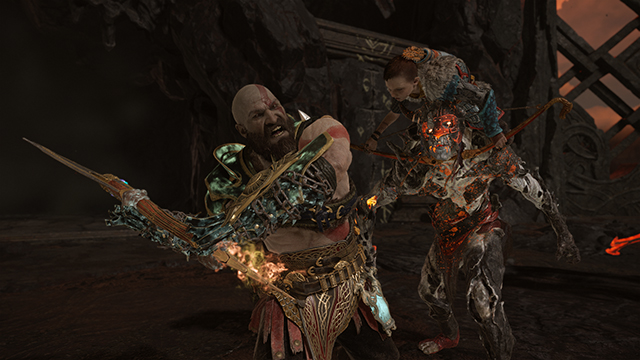
Work on Atreus split into two core traits: autonomous and directive. Going in the autonomous direction first made the team look at how other real people interacted in multiplayer games. And even though they found that real people tend to divide up the battlefield, this meant it was hard to see Atreus since he was doing his own thing somewhere else away from the player. In essence, it felt like he wasn’t doing anything. Hayato expressed a little bit of defeat here.
“At this point, I was like ‘I suck. I should probably update my résumé,’” he jokingly admitted.
Although not all was lost as looking at this allowed Yoshidome to identify the three problems: presence, perceived impact, and weak enemies. Players needed to see Atreus, how he was impacting the enemies, and be able to affect those enemies without doing too much damage.
His presence was addressed in three other key ways: using his bow as a melee weapon, having dynamic poses, and changing positioning behavior. Each had a different yet profound effect on making the boy a better teammate.
Melee bow attacks may seem unintuitive, as Yoshidome pointed out, but it directly puts him near what he is hitting. This way you could actually see him and how he is affecting the battlefield from a quick scan. Dynamic poses also helped players pick him out since his grand jumps, knife attacks, and flashier bow attacks make him stand out. This was added as the game got less grounded over its development and the team “dialed up the anime knob about 30%.”
Positioning

His positioning also changed how players perceived him. Initially, Yoshidome wanted him to prioritize being safe, but this made him look erratic as he was always seeking refuge. Standing his ground was not only more dynamic; it also gave him purpose. He would also teleport closer to player to help as Yoshidome wanted a reliable teammate and not necessarily a realistic one. Overhead views show that he teleports right near Kratos but just out of his periphery so he can more effectively be part of the battle.
Atreus also started helping by getting closer to Kratos and constantly looking at what players were doing. If Kratos launched an enemy, he’d help juggle them. If an enemy was pinned, he would keep them pinned. If Kratos was attacking one specific foe, he’d grab them and help his dad go for a finishing blow. There are many more examples but Yoshidome pointed out that Atreus would extend their vulnerable state so that the “intentionality of the player and Atreus aligned” a bit better.
Sony Santa Monica gave the weaker enemies more health which helped Atreus find his true purpose: creating shortcuts to kill enemies more quickly. It was a pillar mostly out of Yoshidome’s control so the team helped him out by dialing up the opposition’s health bars.
While Atreus also was directed to not interrupt Kratos or attack enemies he was aiming his axe at, he was a bit too offensive. He had almost no defensive way to help Kratos, which was a problem. To counteract this, the team made him call out and protect you from some off-screen attacks, revive the player, and fire arrows to pull some enemies away. This activated when an invisible meter filled that was based on Kratos’ health and if he’s blocking or dodging a lot. Essentially, it would read if the player was being overly defensive and tell Atreus to take some of the heat off Kratos.
Directed action

All of this happened automatically, but team still had a dedicated “Son Button” that it had to address. These directed actions were still far from done. At first, the boy had ice arrows to help with crowd control but that was competing with Kratos’ icy axe so it was dropped. Damaging arrows then followed but were too unpredictable as it was hard to discern when he’d damage an enemy and when he’d go in for a long kill animation. Then there were tagging arrows that would detonate when Kratos would attack them, but this would send enemies flying, thus putting them out of melee range.
But as the player mechanics, UI, and stun system were finalized, Atreus finally began to take more shape. Adding stun was great because it allowed Atreus to help without taking away from Kratos. Runic arrows were formed to apply stun and pull aggro, but also to extend combos and give status effects like shock. Getting aggro also made foes turn their back to Kratos, opening them up for an cleaving.
This put Atreus in the final stretch. RPG mechanics gave players more agency over the kid as player could tailor him to their playstyle and the skill tree added yet another layer to him. It also even gave players a parental role as they were having to spend their skill points to better their child.
After years of going back and forth with Atreus, Yoshidome and his coworkers at Sony Santa Monica had finally made the child go from a liability to an invaluable asset. While he was applauded when the game came out, most people probably didn’t recognize all the minute details that the team had to figure out in order to make the boy a viable teammate to the former god of war. Like Kratos himself, Yoshidome took on the task of parenthood and, with a lot hard work, ended up coming out on top.
